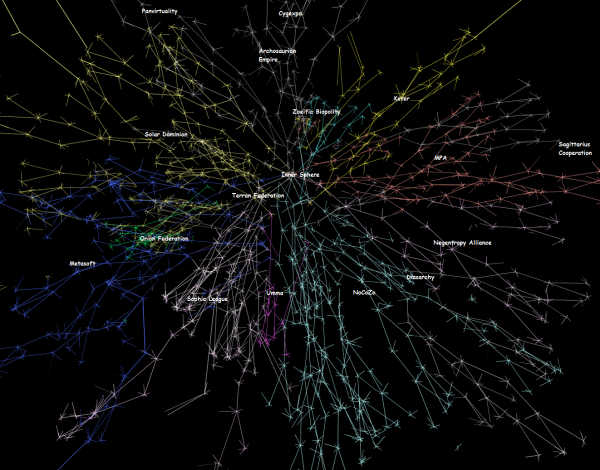BY LETTER
Wormhole Nexus, The
Technology > Application > Communications
Technology > Application > Transportation > Interstellar Transport
Technology > Application > Metric Engineering
Technology > Technology Type or Material > Space-Time Engineering
Technology > Technology Levels > Transapientech / Godtech / Clarketech
Technology > Application > Transportation > Interstellar Transport
Technology > Application > Metric Engineering
Technology > Technology Type or Material > Space-Time Engineering
Technology > Technology Levels > Transapientech / Godtech / Clarketech
 Image from Steve Bowers |
The largest connected system ever built by Terragens, the wormhole nexus is a modular and ever expanding network of artificial wormholes, which already spans much of explored space. More than six millennia old, it is still growing at an accelerating pace that shows no signs of abating. While there are several smaller nexi still unconnected to the main network, when one speaks of the Nexus there is no doubt what is being referred to.
The Nexus is more than just a multi-millennial ongoing project, and more than all the billions of physical and exotic matter structures and the quadrillions more support structures, superstructures and maintenance and service ai. It is the symbol of Civilization itself, trumpeted at isolates and xenos and even at other ordinary Terragens, to prove that Sephirotic civilization is the largest, mightiest, greatest empire ever! It allows even the most humble baseline to cross from one end of the known galaxy to the other in only five or six standard months of shipboard transit interspersed with instantaneous wormhole 'jumps'. It is the circulatory system of the entire Terragen bubble, conveying goods, services, data streams, and sentients of all kinds to where they are needed, or where they wish to go.
And yet, for all of its size, cost, and miraculous technology, the Nexus is something that most beings in the galaxy hardly give a second thought to. It is there, always functioning smoothly, allowing the wonderful Terragen civilization to exist and flourish. It works quietly, in the background, like the Known Net. All sophonts are assured that if they want to go somewhere, and provided they have the monetary credit to pay the very reasonable tolls (in those polities that use them) then they can do so without fear to life or limb. While tolls vary from non-existent to exorbitant, depending on the local polity, it is a fact that travel through the Nexus is often easier than travel from one end of a planet or megahabitat to another!
 Image from Avengium | |
| Symbolic depictions of the Nexus as a series of fractals | |
Configuration of the Nexus
With some local exceptions (most notably the ancient Inner Sphere wormhole links) the general configuration of the Nexus is based on a branching network of relay systems. Few wormholes directly link inhabited system to inhabited system. Instead most link to relays; clusters of approximately 100 wormholes packed within a light month of a suitable star. The relay star itself is rarely inhabited but instead is heavily re-engineered by supervising archai for material to maintain the Nexus, as well as for their matrioshkas. Maintenance is comprised of: mass for new wormholes (see Weylforge), energy for beamrider transport, gravity tug swarms to maintain the chaotic orbits of so many wormholes and many more routine engineering requirements. The average relay system connects to inhabited systems, "higher level" relays and "lower level" relays in a 90:9:1 ratio. Higher level relays are more distal relays in the network, further away from Aksijaha, lower level are closer.In some cases relay systems will connect across branches to linker systems that host a pair of wormholes, each leading to a different relay. Great care must be taken to set up linker systems in such a way that no CTC forms, the margin of error in many cases is <0.1%. Linker systems are always approximately equidistant between the two relays and, as with other wormhole links, extend radially from the center of the network. Linker systems are most common in lower level relays with the 1st Relay Layer host to the first fully connected "ringroad" known as Aksijaha's halo. The 2nd Relay Layer boasts a nearly complete ring and the 3rd layer has begin to construct more linkers over the past two millennia. Some linker systems are relays in a more distal level of the nexus, allowing not only for traffic across the nexus but simultaneously along it. Aside from alleviating traffic through root systems linkers confer ensure the Nexus would remain connected even in event of major loss of route relays (as was the case in the formation of the Red Star M'Pire). The presence of linker systems at the nexus core has been dubbed by many as the snowflake configuration.
There are five complete levels to the Nexus with many sixth level relays under development. In total the nexus connects approximately ten million systems. Thanks to this for the most part only a dozen wormhole crossings are needed to get from one edge of the Nexus to the other, a journey of more than 10,000 lightyears. At lower accelerations a pan-Nexus crossing can take a matter of decades, at higher it can be done in a few short years.
The network of comm-gauge wormholes is also arranged in this manner and often (but not always) overlaps the physical nexus perfectly. Due to the nature of comm wormholes they can be packed in a much tighter space, their relay clusters are often mere light minutes apart and can be inside the relay matrioshka. Communication from one side of the nexus to the other can take less than a standard day, depending on sender/recipient distance to a comm wormhole as well as routing priority.
Other Nexi
The first wormhole nexus to be discovered was the Taurus Nexus, created by a very early a-human transapient civilisation in the First Federation era. Later parts of the alien nexus built by the Tunh were discovered, although the component parts of this nexus have mostly disappeared and the few that remain have drifted far apart. Other entirely independent nexi have been built, such as the Diamond Nexus and the Panvirtuality Nexus, and the later Lirantiq nexus which has since been connected to the main network.Wormholes come in two main kinds:
Traversable wormholes, which use a modified Morris-Thorne-Kuhfittig metric. These are very large: traversable wormholes are consistently 327 Astronomical Units (A.U.s) in radius from the region of flat-space to the wormhole mouth. This kind of wormhole uses a relatively small quantity of negative (exotic) ANEC-violating energy. This is the kind of wormhole often referred to as a stargate.
Hayward class wormholes which are much smaller, but use a much larger amount of negative (exotic) ANEC-violating energy. They are only useful for transmitting em-beams containing data, but this data transfer is very important to the existence of civilisation in the Terragen Sphere.
 Image from Steve Bowers | |
| Overview of the Wormhole Nexus in the Middle Regions and Inner Sphere | |
Related Articles
- Chronology Protection
- Fargate, The - Text by Todd Drashner
Wormhole of presumably alien manufacture discovered in the Metasoft volume in 10233. Travel through the gate transports one to a location in intergalactic space. The exact location in relation to the Milky Way galaxy is unknown since instruments sent through the portal have been unable to pinpoint any familiar configurations of galaxies. It is hypothesized that the Fargate may exit beyond the current universal Event Horizon or even into another universe. There is of course no evidence for this and most serious researchers are confident that the coordinates for The Other Side, as it is called, will be pinpointed eventually. - God Web, The
- High Road, The
- Known Net, The
- Kuranaba Gate
- Linelayer
- Lirantiq Nexus
- Nexus, The - Text by Orion's Arm Editors
The common term for the Wormhole Nexus. - Sagittarius Project - Text by Anders Sandberg
Major exploration project backed by a number of research and colonization megacorporations in the Establishment and early Consolidation era. The Sagittarius Project attempted to set up wormhole links to the Sagittarius arm and continue inwards to the galactic core. Over time, the Project developed into a megacorp-house like most others (eventually becoming the Sagittarius Sphere), and the thrust towards the core was replaced by exploiting the many new worlds found in the Sagittarius arm. Some research vessels are still on their way towards the core, and are expected back in a few millennia. - Stargate
- Taurus Nexus
- Vega
- Visser Effect
- W-Brain, Distributed Wormhole Brain
- Weylforge
- Wormhole Bus
- Wormhole Gazetteer
- Wormhole Termini
- Wormholes - A Layman's Guide
- Wormholes - Cultural Factors
Appears in Topics
| Communications | Interstellar Transport | Metric Engineering |
| Space-Time Engineering | Transapientech / Godtech / Clarketech |
Development Notes
Text by Anders Sandberg and M. Alan Kazlev
Initially published on 03 October 2001.
See also: Wormholes FAQ
Initially published on 03 October 2001.
See also: Wormholes FAQ






